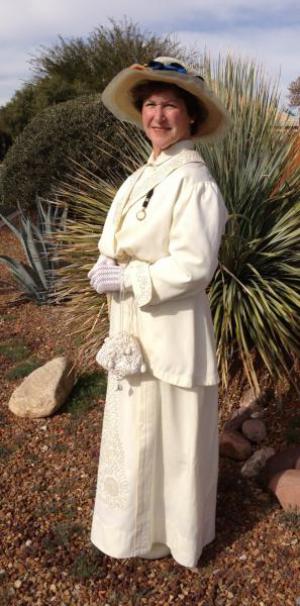Circles of Influence

Note: Karen Board Moran first “encountered” Lucy Stone at the Schlesinger Library twenty years ago. Their “paths” crossed not only in Worcester Woman’s History Project activities, but in LaCrosse and Viroqua, Wisconsin, where Moran had attended college and had done her student teaching. Amazingly, upon retirement to Tucson, their circles of influence once more coincided. This article brings Stone and Moran full circle as Moran continues to reenact Lucy and those she influenced. Contact Karen at kboardmoran@comcast.net for data base of 1913 female voters.
At the 1850 first National Woman’s Rights Convention held in Worcester, Massachusetts, Lucy Stone and others called for “…Equality before the law, without distinction of sex or color.” She dedicated her life to that end and inspired women like Susan B. Anthony to join the effort. Following the Civil War, Anthony and Elizabeth Cady Stanton favored Constitutional universal suffrage while Stone and other Abolitionists gained Black males the vote and formed the American Woman Suffrage Association to continue a state by state effort. After many years of divisiveness, reconciliation was achieved with the help of Stone’s daughter, Alice Stone Blackwell, with the 1890 formation of National American Woman Suffrage Association.
Meanwhile in Arizona Territory, pioneer women struggled for those same rights Stone had advocated forty years earlier. Pima County women had been gathering in parlors on Main Street, at Woman’s Christian Temperance Union meetings, on the newly opened University of Arizona campus and in the library above the city hall to discuss a stronger role for women. Two years before her death, Stone sent Laura Johns of Kansas to work with Tucsonan Josephine Brawly Hughes to help form the Arizona Territory Equal Suffrage Association (1891).
Their challenge was to change the traditional role of women in society. Many agreed with the 1883 AZ Weekly Democrat that “The women of the territory don’t want to wear the breeches. Leave the ladies to their tea parties and home work.”
Strong liquor and anti-Mormon interests blocked the Suffrage Bill in the Arizona State Constitution of 1912. In addition an English language requirement effectively decreased input from the Hispanic majority of Pima County (part of 1853 Gadsden Purchase from Mexico).
On 5 November 1912 Arizona suffragists were finally victorious in a initiative referendum effort becoming the ninth state where women were equal citizens. Four months later the state legislature finally agreed to not require one’s exact age be given and voter registration opened to women March 15 to May 1.
Tucsonan Clara Fish Roberts was first to register followed by almost 600 Pima County women (about 1/6 of those eligible). A concerted effort by different women’s groups rallied women to enter the strange world of politics. The Collegiate Club (today’s American Association of University Women), founded by Roberts, held educational lectures about the process and responsibilities. Housewives and teachers led the way. Amazingly five Black and about ten Hispanic women joined Anglo women in taking this first bold step.
The fears of liquor interests became a reality as Arizona Prohibition took effect New Year’s Day 1915. Suffragist leaders were elected such as State Senator Frances Munds and State Legislator Rachel Berry to represent the interests of women and children.
The U. S. Constitutional Suffrage Amendment passed on 26 August 1920, a year after passage of the Prohibition Amendment without females’ ballots.
How will YOU continue to use this hard won right and help fulfill the 1850 Woman’s Rights Convention vision? Encourage and educate all eligible voters to register and cast your ballot to honor Lucy Stone and your foremothers.

